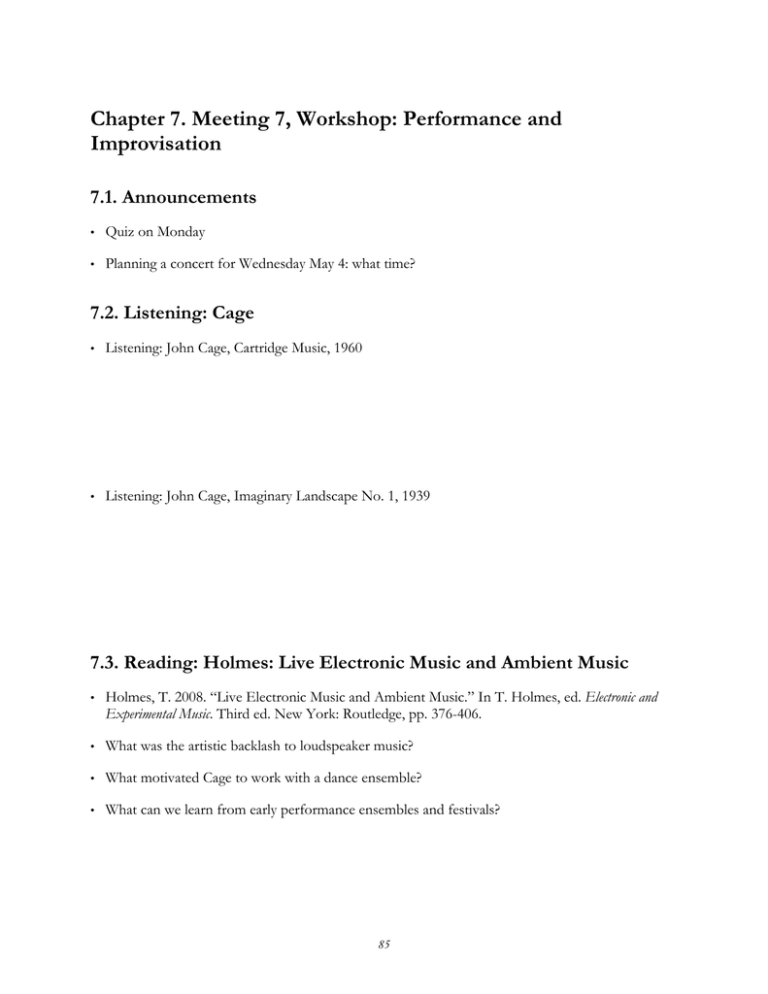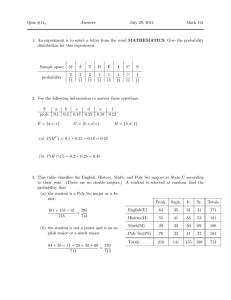
Chapter 7. Meeting 7, Workshop: Performance and
Improvisation
7.1. Announcements
•
Quiz on Monday
•
Planning a concert for Wednesday May 4: what time?
7.2. Listening: Cage
•
Listening: John Cage, Cartridge Music, 1960
•
Listening: John Cage, Imaginary Landscape No. 1, 1939
7.3. Reading: Holmes: Live Electronic Music and Ambient Music
•
Holmes, T. 2008. “Live Electronic Music and Ambient Music.” In T. Holmes, ed. Electronic and
Experimental Music. Third ed. New York: Routledge, pp. 376-406.
•
What was the artistic backlash to loudspeaker music?
•
What motivated Cage to work with a dance ensemble?
•
What can we learn from early performance ensembles and festivals?
85
7.4. Poly Performance C (mgSynthNoiseFilter, mgSynthBuffer8,
mgSynthSaw)
•
Poly: 3 instruments
•
Instrument 1: mgSynthNoiseFilter
Joystick controller photo © Logitech. All rights reserved. This content is excluded from our Creative Commons license.
For more information, see http://ocw.mit.edu/fairuse.
•
Instrument 2: mgSynthBuffer8
86
Joystick controller photo © Logitech. All rights reserved. This content is excluded from our Creative Commons license.
For more information, see http://ocw.mit.edu/fairuse.
•
Instrument 3: mgSynthSaw
87
Joystick controller photo © Logitech. All rights reserved. This content is excluded from our Creative Commons license.
For more information, see http://ocw.mit.edu/fairuse.
7.5. Instruments and Scenes
•
A scene defines present for all instruments in the poly instrument
•
Advancing the scene (buttons 9+10 together) changes all presets
•
Generally used for large-scale changes
7.6. Exercise: Smooth Fades
•
Load: poly performance-c.test.pd
martingale/pd/instruments/dualAnalog*/poly/performance-c.test.pd
88
•
Ensemble: instrument 1: fade in over 8 counts, fade out over 8 counts
•
Variation: in over 4, out over 4 + 8
Variation: in over 8 + 4, out over 4
7.7. Exercise: Scales
•
Load: poly performance-c.test.pd
martingale/pd/instruments/dualAnalog*/poly/performance-c.test.pd
•
Ensemble: instrument 3: scene 2: ascending and descending scale, repeating top note
•
Variation: improvise with timber, filters, dyanmics
Variation: legato v. staccato
Variation: shift octave
Variation: open filter in ascent, close filter in descent
7.8. Exercise: Scales
•
Load: poly performance-c.test.pd
martingale/pd/instruments/dualAnalog*/poly/performance-c.test.pd
•
Ensemble: instrument 3: scene 2: ascending and descending scale, repeating top note
•
Variation: improvise with timber, filters, dyanmics
Variation: legato v. staccato
Variation: shift octave
Variation: open filter in ascent, close filter in descent
7.9. Exercise: Drone Swells
•
Load: poly performance-c.test.pd
martingale/pd/instruments/dualAnalog*/poly/performance-c.test.pd
•
Performer A: instrument 3: scene 1: select a pitch and sustain, adding dynamic and timbral
variation
89
•
Ensemble: instrument 3: scene 1: each performer enters and finds the same pitch (possible at the
same octave)
•
Variation: Performer A chooses one pitch, Performer B chooses a second pitch, ensemble
duplicates
•
Variation: Performer A, B, and C each choose different pitches; ensemble then enters
7.10. Exercise: Eight On / Eight Off
•
Load: poly performance-c.test.pd
martingale/pd/instruments/dualAnalog*/poly/performance-c.test.pd
•
Ensemble: instrument 2: scene 2, 3, or 4: articulate 8 beats in-time, on major beats or divisions
(not necessarily uniform)
•
Ensemble: Silence for 8 beats, or short rhythms or gestures in-time within 8 beat span or less
•
Variation: change instruments during 8 beats and create alternative gestures
7.11. Exercise: Sixteen Beat Patterns
•
Load: poly performance-c.test.pd
martingale/pd/instruments/dualAnalog*/poly/performance-c.test.pd
•
Ensemble: instrument 2: scene 2, 3, or 4: articulate all numbered beats
•
Beats with dynamics
•
1 x 3 x 1 2 3 x 1 x 3 x 1 x x x
1 2 3 4 1 x 3 x 1 2 3 4 x x 3 4
1 2 x 4 1 x 3 4 x 2 x 4 x 2 3 x
•
Variation: selected performers take solos over beat
Variation: divide in two: group A does on beats, group B does background with instrument 1
Variation: divide in two: group A does on beats, group B does drones with instrument 3: scene 2
Variation: divide in two: group A does on beats, group B does off beat
Variation: divide in four: group A does off beats, group B does on beats, group C does drones
with instrument 3: scene 2, group D does does background with instrument 1
90
7.12. Exercise: Pass-the-Gesture Solo
•
Load: poly performance-c.test.pd
martingale/pd/instruments/dualAnalog*/poly/performance-c.test.pd
•
Performer A: Create a memorable musical gesture, lasting between 5 and 15 seconds
•
Performer B: Re-create the musical gesture of Performer A, not necessarily using the same sound
source, but maintaining temporal and spectral outline.
•
Continue process from performer to performer, moving around in a circle
7.13. Exercise: Pass-the-Gesture Ensemble
•
Load: poly performance-c.test.pd
martingale/pd/instruments/dualAnalog*/poly/performance-c.test.pd
•
Ensemble: Create a subtle, low frequency background texture, contributing a small bit to the total
sound
Performer A: Create a memorable musical gesture, lasting between 5 and 15 seconds; repeat it
twice, with variable space in-between gestures.
•
Performer B: Re-create the musical gesture of Performer A, not necessarily using the same sound
source, but maintaining temporal and spectral outline.
Ensemble: Continue
•
Continue process from performer to performer, moving around in a circle
•
Variation: Performers A and B selected in pairs: A and B in a dialog or argument
•
Variation: Performer B responds to A not in similarity, but maximal contrast, producing the
opposite idea
91
MIT OpenCourseWare
http://ocw.mit.edu
21M.380 Music and Technology: Live Electronics Performance Practices
Spring 2011
For information about citing these materials or our Terms of Use, visit: http://ocw.mit.edu/terms.

